Lesson 7
Reasoning about Solving Equations (Part 1)
7.1: Hanger Diagrams (10 minutes)
Warm-up
Students encounter and reason about a concrete situation, hangers with equal and unequal weights on each side. They then see diagrams of balanced and unbalanced hangers and think about what must be true and false about the situations. In subsequent activities, students will use the hanger diagrams to develop general strategies for solving equations.
Launch
Display the photo of socks and ask students, “What do you notice? What do you wonder?”
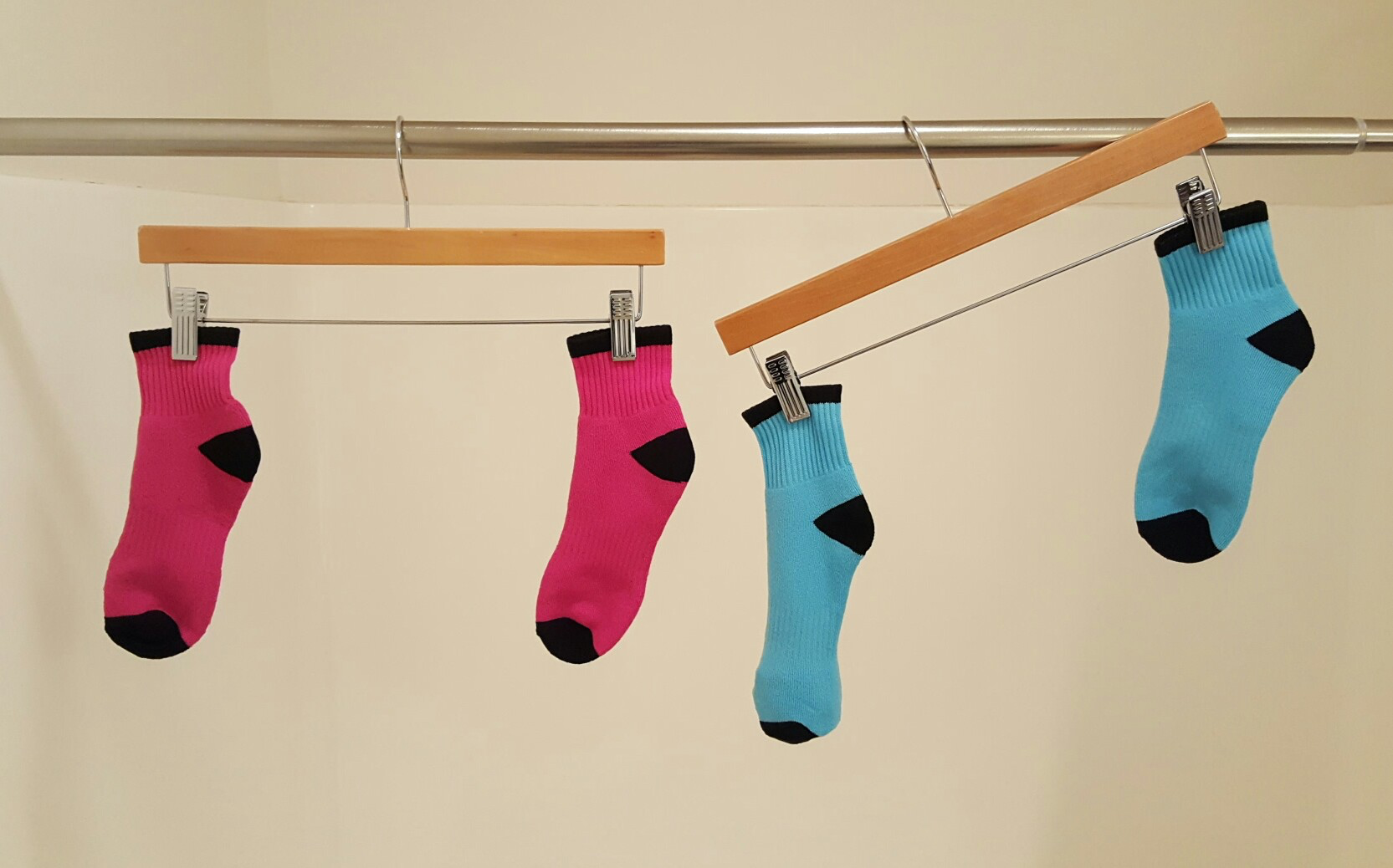
Give students 1 minute to think about the picture. Record their responses for all to see.
Things students may notice:
- There are two pink socks and two blue socks.
- The socks are clipped to either ends of two clothes hangers. The hangers are hanging from a rod.
- The hanger holding the pink socks is level; the hanger holding the blue socks is not level.
Things students may wonder:
- Why is the hanger holding the blue socks not level?
- Is something inside one of the blue socks to make it heavier than the other sock?
- What does this picture have to do with math?
Use the word “balanced” to describe the hanger on the left and “unbalanced” to describe the hanger on the right. Tell students that the hanger on the left is balanced because the two pink socks have an equal weight, and the hanger on the right is unbalanced because one blue sock is heavier than the other. Tell students that they will look at a diagram that is like the photo of socks, except with more abstract shapes, and they will reason about the weights of the shapes.
Give students 3 minutes of quiet work time followed by a whole-class discussion.
Student Facing
In the two diagrams, all the triangles weigh the same and all the squares weigh the same.
For each diagram, come up with . . .
- One thing that must be true
- One thing that could be true
- One thing that cannot possibly be true

Student Response
For access, consult one of our IM Certified Partners.
Activity Synthesis
Ask students to share some things that must be true, could be true, and cannot possibly be true about the diagrams. Ask them to explain their reasoning. The purpose of this discussion is to understand how the hanger diagrams work. When the diagram is balanced, there is equal weight on each side. For example, since diagram B is balanced, we know that one triangle weighs the same as three squares. When the diagram is unbalanced, one side is heavier than the other. For example, since diagram A is unbalanced, we know that one triangle is heavier than one square.
7.2: Hanger and Equation Matching (15 minutes)
Activity
Students are presented with four hanger diagrams and are asked to match an equation to each hanger. They analyze relationships and find correspondences between the two representations. Then students use the diagrams and equations to find the unknown value in each diagram. This value is a solution of the equation.
Launch
Display the diagrams and explain that each square labeled with a 1 weighs 1 unit, and each shape labeled with a letter has an unknown weight. Shapes labeled with the same letter have the same weight.
Arrange students in groups of 2. Give 5–10 minutes of quiet work time and time to share their responses with a partner, followed by a whole-class discussion.
Supports accessibility for: Visual-spatial processing
Student Facing
On each balanced hanger, figures with the same letter have the same weight.
- Match each hanger to an equation. Complete the equation by writing \(x\), \(y\), \(z\), or \(w\) in the empty box.
- \(2 \boxed{\phantom{3}} + 3 = 5\)
- \(3 \boxed{\phantom{3}} + 2 = 3\)
- \(6 = 2 \boxed{\phantom{3}} + 3\)
-
\(7 = 3 \boxed{\phantom{3}} + 1\)
- Find the solution to each equation. Use the hanger to explain what the solution means.
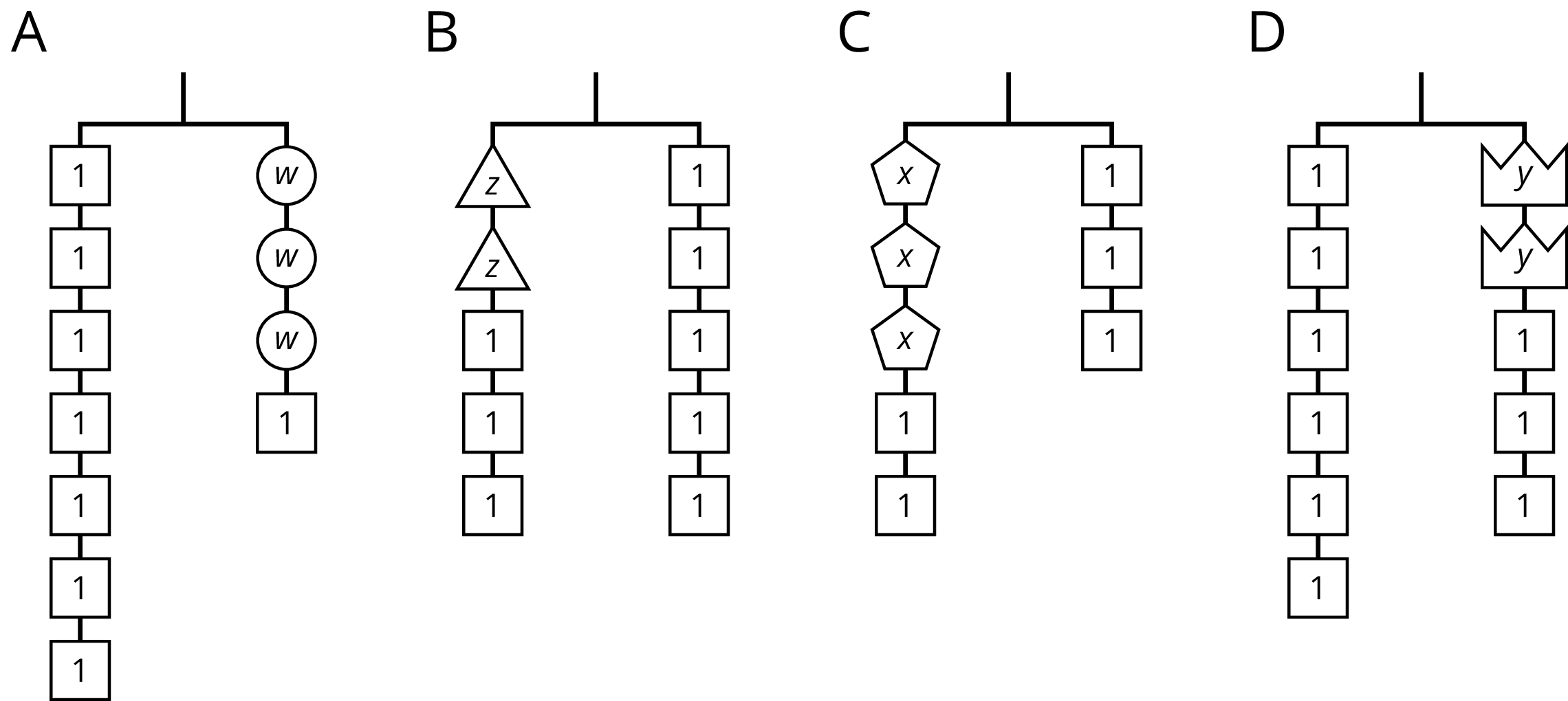
Student Response
For access, consult one of our IM Certified Partners.
Activity Synthesis
Demonstrate one of the hangers alongside its equation, removing the same number from each side, and then dividing each side by the same thing. Show how these moves correspond to doing the same thing to each side of the equation. (See the student lesson summary for an example of this.)
Design Principle(s): Maximize meta-awareness; Cultivate conversation
7.3: Use Hangers to Understand Equation Solving (15 minutes)
Activity
This activity continues the work of using a balanced hanger to develop strategies for solving equations. Students are presented with balanced hangers and are asked to write equations that represent them. They are then asked to explain how to use the diagrams, and then the equations, to reason about a solution. Students notice the structure of equations and diagrams and find correspondences between them and between solution strategies.
Launch
Draw students’ attention to the diagrams in the task statement. Ensure they notice that the hangers are balanced and that each object is labeled with its weight. Some weights are labeled with numbers but some are unknown, so they are labeled with a variable.
Keep students in the same groups. Give 5–10 minutes of quiet work time and time to share their responses with a partner, followed by a whole-class discussion.
Student Facing
Here are some balanced hangers where each piece is labeled with its weight. For each diagram:
- Write an equation.
- Explain how to figure out the weight of a piece labeled with a letter by reasoning about the diagram.
- Explain how to figure out the weight of a piece labeled with a letter by reasoning about the equation.
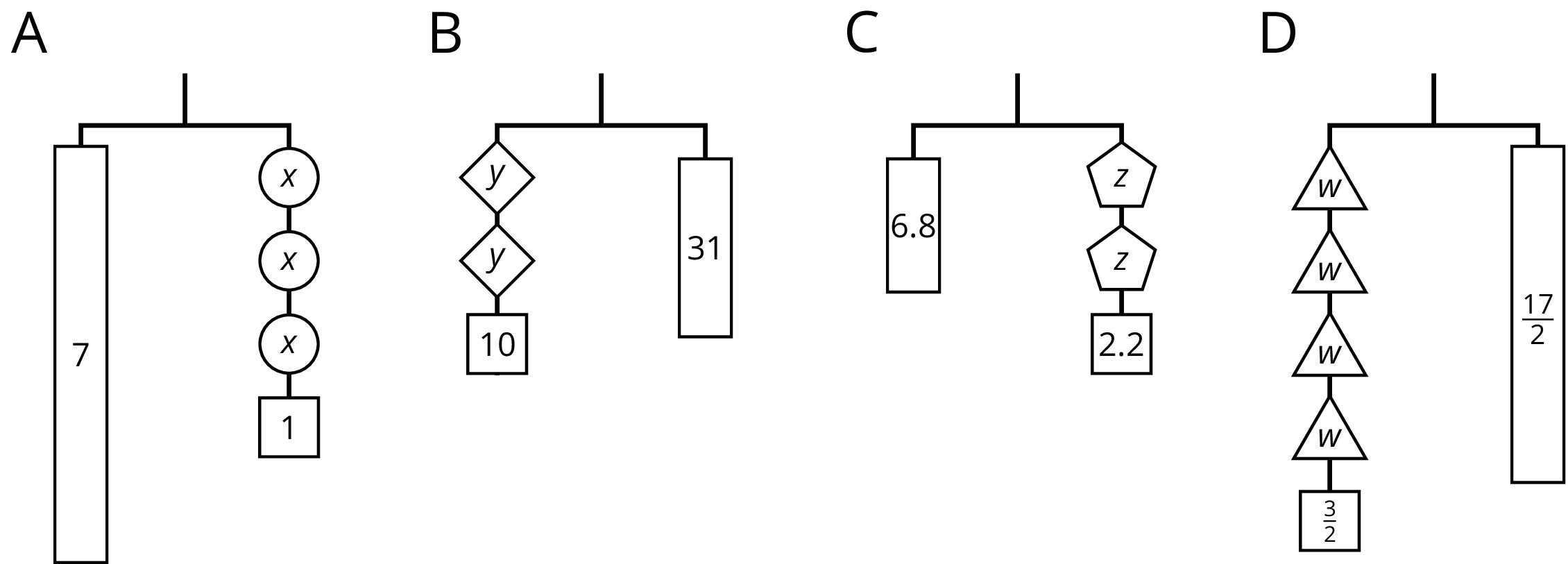
Student Response
For access, consult one of our IM Certified Partners.
Activity Synthesis
Invite students to demonstrate, side by side, how they reasoned with both the diagram and the equation. For example, diagram A can be shown next to the equation \(7=3x+1\). Cross out a piece representing 1 from each side, and write \(7-1=3x+1-1\), followed by \(6=3x\). Encircle 3 equal groups on each side, and write \(6 \div 3 = 3x \div 3\), followed by \(2=x\). Repeat for as many diagrams as time allows. If diagrams A and B did not present much of a challenge for students, spend most of the time on diagrams C and D.
We want students to walk away with two things:
- An instant recognition of the structure of equations of the form \(px+q=r\) where \(p\), \(q\), and \(r\) are specific, given numbers.
- A visual representation in their minds that can be used to support understanding of why for equations of this type, you can subtract \(q\) from each side and then divide each side by \(p\) to find the solution.
Supports accessibility for: Memory; Language
Design Principle(s): Optimize output (for explanation); Cultivate conversation
Lesson Synthesis
Lesson Synthesis
Display the equation \(4x+6=9.2\). Ask students to work with their partner to draw a corresponding hanger diagram. Then, one partner solves by reasoning about the equation, the other solves by reasoning about the diagram. Ask students to compare the two strategies and discuss how they are alike and how they are different.
7.4: Cool-down - Solve the Equation (5 minutes)
Cool-Down
For access, consult one of our IM Certified Partners.
Student Lesson Summary
Student Facing
In this lesson, we worked with two ways to show that two amounts are equal: a balanced hanger and an equation. We can use a balanced hanger to think about steps to finding an unknown amount in an associated equation.
The hanger shows a total weight of 7 units on one side that is balanced with 3 equal, unknown weights and a 1-unit weight on the other. An equation that represents the relationship is \(7=3x+1\).

We can remove a weight of 1 unit from each side and the hanger will stay balanced. This is the same as subtracting 1 from each side of the equation.
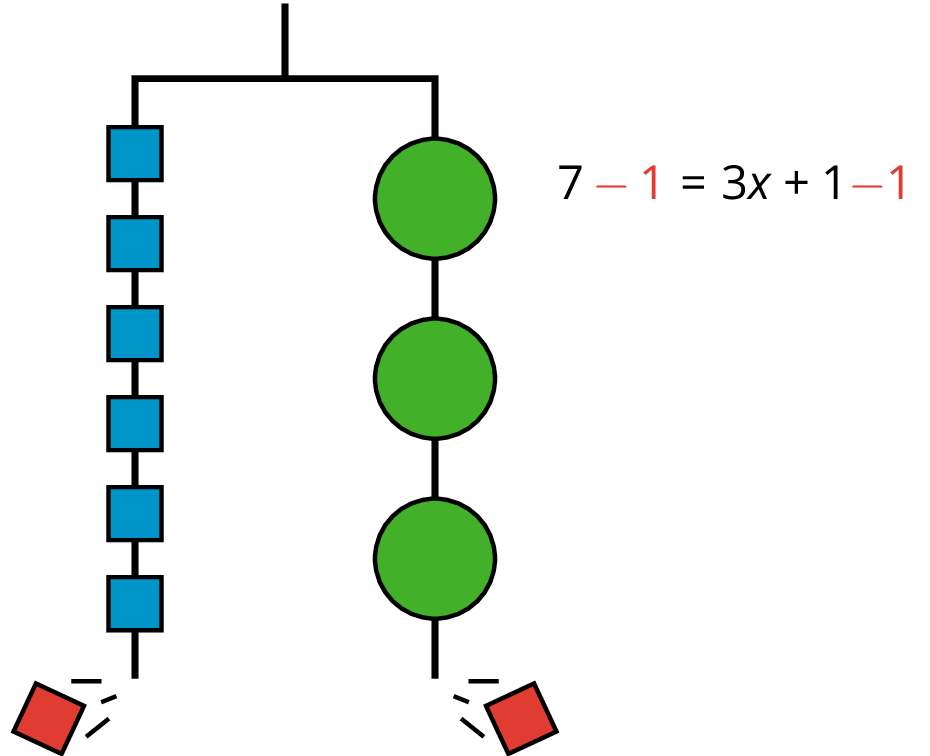
An equation for the new balanced hanger is \(6=3x\).
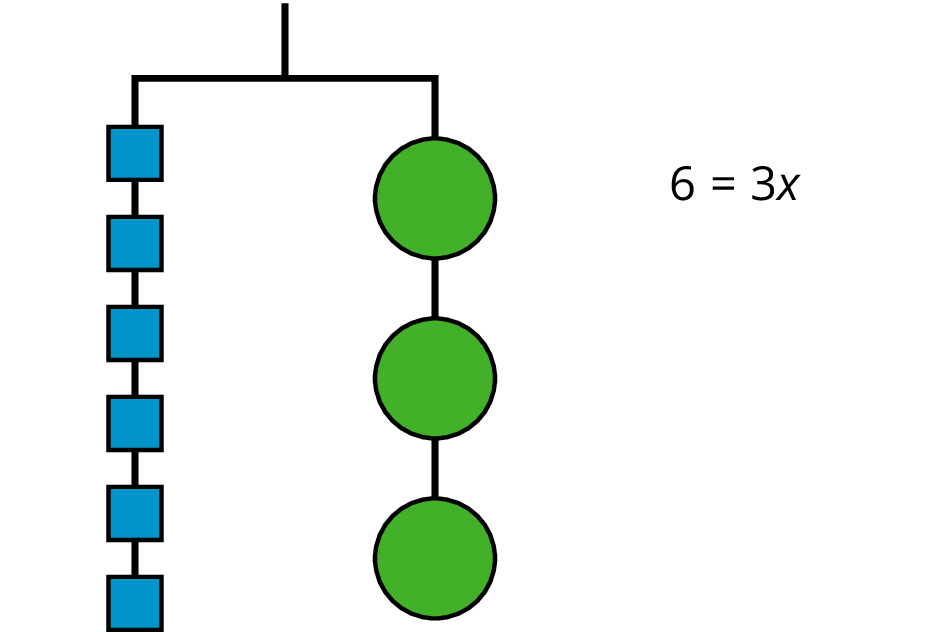
So the hanger will balance with \(\frac13\) of the weight on each side: \(\frac13 \boldcdot 6 = \frac13 \boldcdot 3x\).
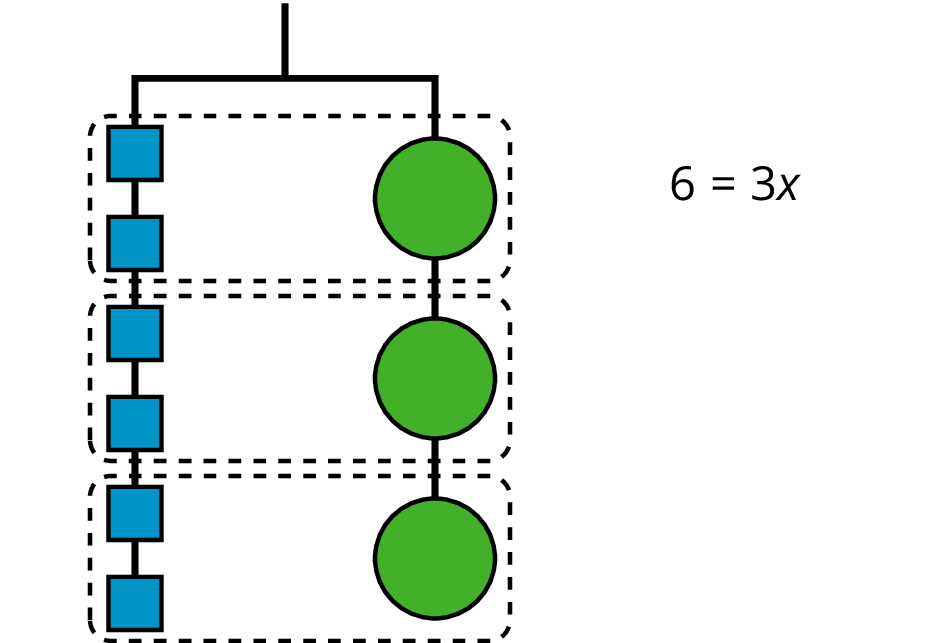
The two sides of the hanger balance with these weights: 6 1-unit weights on one side and 3 weights of unknown size on the other side.

Here is a concise way to write the steps above:
\(\begin {align} 7&=3x+1 & \\ 6&=3x & \text{after subtracting 1 from each side} \\ 2 &= x & \text{after multiplying each side by } \tfrac13 \\ \end{align}\)